Natural Causes
Landscape photographs by Ansel Adams and Eliot Porter
Gael Newton
Originally published by NGA as a touring exhibition brochure 1999
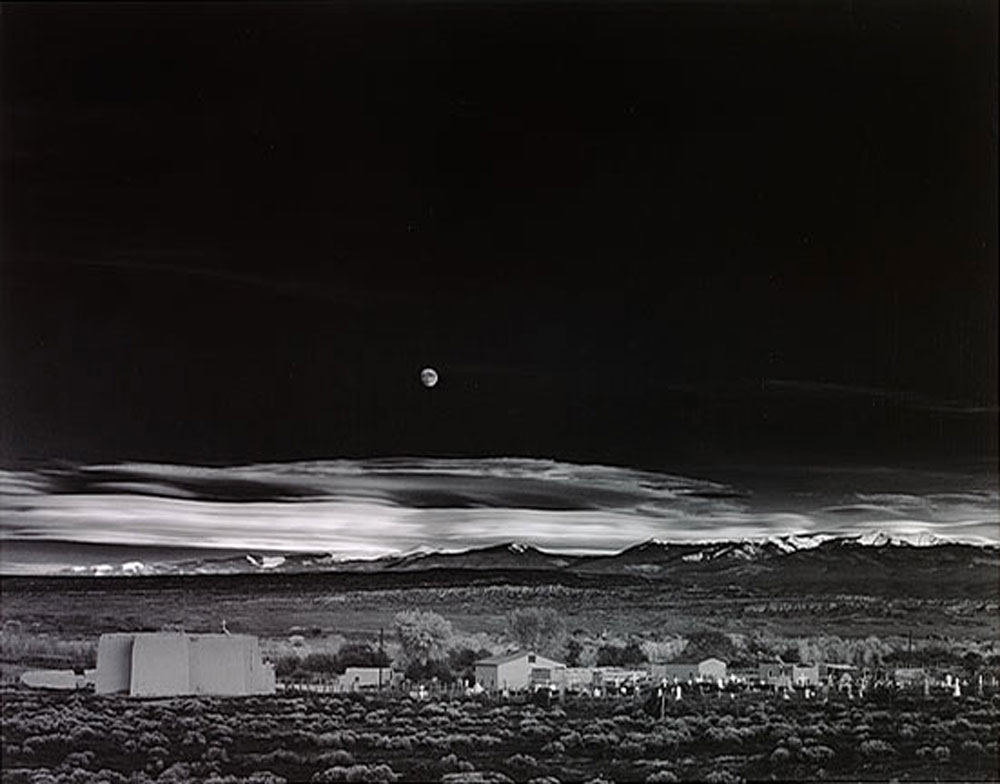 |
Ansel Adams 1902-1984 Moonrise, Hernandez, New Mexico 1941
gelatin silver photograph
38.6 x 49.0 cm |
Ansel Adams and Eliot Porter are probably the most widely appreciated twentieth-century photographers of the natural world. They are renowned for their creative vision and contributions to the history of photography.
Both were keen amateur photographers from their teenage years: Adams, whose first ambition was to be a classical pianist, turned his hobby into his profession in 1926; Porter was first a biochemist before taking up photography as a full-time occupation in 1939.
Both achieved considerable recognition, received numerous awards and were given museum shows. Both were active in wilderness preservation: in particular their photographs featured in the publications of the Sierra Club, which had been established in California in 1892 and was a model for activist wilderness societies across the world in the 1960s and 1970s.
 |
Eliot Porter 1901-1990 Pool in a brook. Pond Brook, near Whiteface, New Hampshire. October 1953
large print edition of the portfolio Intimate Landscapes, New York: Daniel Wolf Press Inc., 1979 dye-transfer colour photograph 92.6 x 72.4 cm |
Adams and Porter present quite different approaches to nature. Adams' landscapes of the national parks of California or the desert regions of the south-west of America show a 'natural' world in monochrome from which man and beast, bird and flower are largely absent. His characteristic view is a long, distant and deep one through an open foreground. Adams favoured dusk and dawn and dramatic weather — he thought mid-day light too prosaic. In his authorised canon, colour images are rare — although a body of this work has been published. He felt colour photography could not be art. Porter similarly excludes the human presence but embraces diversity and intricacy in a many-hued dynamic natural environment in which flora and fauna interact.
Both men deplored the degradation of wilderness by pollution, development and tourism. Both grew up in areas of great natural beauty by the sea: Adams' home was in San Francisco; Porter spent family holidays on an island in Maine. Their subsequent careers grew out of their respective childhood experiences of nature.
Although they were not friends, Porter and Adams knew each other and, at the outset of his career, Porter was inspired by the latter's technical and conceptual achievements. For his part, Adams may have found the extent of recognition given to Porter's small and intricate colour work a little puzzling since it lacked the grandeur and overt emotional impact which he valued in large format black and white photography. In Adams' photographs, one can imagine the wilderness
is as fresh as it was when the famous landmarks of the American west were first discovered.
Americans such as the writer Henry David Thoreau (1817-1862) and pioneer conservationist John Muir (1838-1914), founder of the Sierra Club, believed their land of great natural wonders represented the pioneer spirit and shaped the national character and, in return, demanded reverence and protection. Adams and Porter seem to have understood and shared this tradition. Historically, Adams' work can be related to the elevated and panoramic viewpoints of eighteenth- and nineteenth-century topographic art, Porter's to the dedicated and faithful depiction of flora and fauna of John James Audubon (1785-1851), who made a vast study of the birds of America.
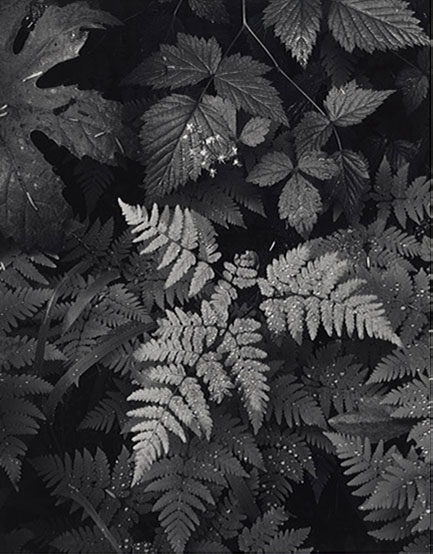 |
|
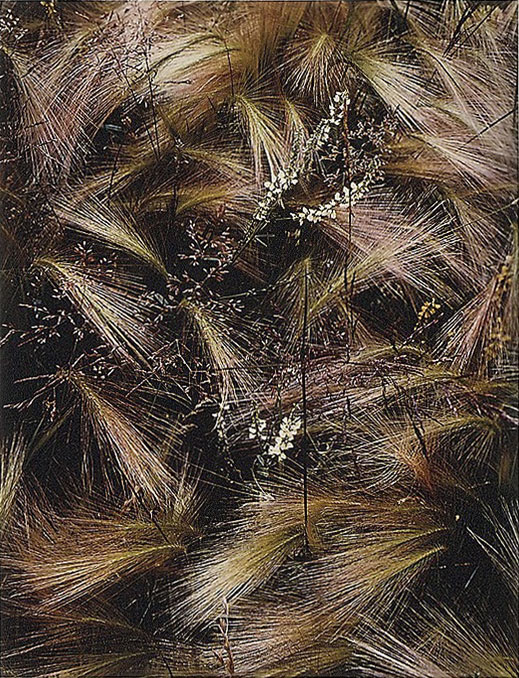 |
Ansel Adams 1902-1984 Leaves, Mount Rainier National Park, Washington 1942 gelatin silver photograph 47.4 x 37.0 cm
|
|
Eliot Porter 1901-1990 Foxtail grass. Lake City, Colorado. August 1957 from the portfolio Intimate Landscapes, New York: Daniel Wolf Press Inc., 1979 dye-transfer colour photograph 33.8 x 27.3 cm |
Adams' printing style of tonally scintillating masses defined by exquisitely delineated edges derives from his technical expertise with modern photographic equipment and the chemistry of development. Porter acquired great skill in highly detailed and tonally faithful colour photography and the use of stroboscopic flash to capture fauna in their environment.
Adams is regarded as a modern master and teacher of black and white photography. His influence has been extended through the series of widely used 'how-to-do-it' manuals he published, which also gave details of his method for precisely pre-visualising exposure and development, known as the zone system. While Porter began his photographic career in black and white work, he chose to develop his colour photography in order to do justice to the intricate beauty and diversity of his subject. He learned the laborious and demanding dye-transfer process which gave great fidelity and was archivally permanent.
Adams' favourite place and subject was the Yosemite Valley and the surrounding Sierra Nevada range, but he also made major studies of pueblo Indian dwellings and the monumental forms and sparse vistas of the arid south-west desert regions of Arizona, New Mexico, Colorado and Utah. He visited the eastern states and New York only as was professionally necessary.
His first journey overseas, to a photography festival in Aries, France, was undertaken in 1974 when he was 72. He made other trips in later years, taking photographs in France and Scotland, but these have not been widely published. Porter, at 73 in 1975, made his first trip to the Antarctic after many visits to other geographic and ecological wonders of the world. He published numerous articles and books on his journeys.
Adams provided most of the images for the first of the Sierra Club's highly successful large format 'exhibition' publications, This is the American Earth of 1960. The book was devised by Adams and included a text with wide literary and spiritual quotations by his friend, the writer and curator Nancy Newhall. This was a first step in the process which led to Adams becoming for many in the 1960s and 1970s, their catalyst to an awareness and enthusiasm for both conservation and photography as art.
Porter had the longer and perhaps more involved association with publications in direct political support of conservation issues and the celebration of a full spectrum of nature. Porter's work was published in nature magazines from the 1940s to the 1960s, but the Sierra Club small format publication of 1962 titled In Wildness is the Preservation of the World — in which pictures were set to the texts of Thoreau — was his great success. His next Sierra Club publication, The Place No One Knew of 1963, was about Glen Canyon, a tributary of the Grand Canyon which was to be submerged in the rising waters of Lake Powell following final construction of Glen Canyon Dam in 1964.
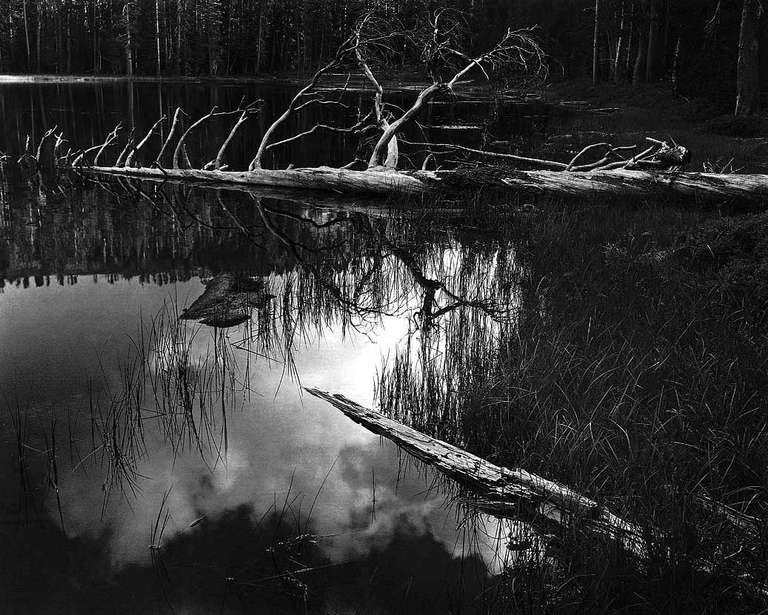 |
|
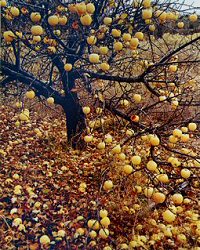 |
Ansel Adams 1902-1984 Siesta Lake, Yosemite National Park, California 1958 gelatin silver photograph 39.6 x 49.2 cm
|
|
Eliot Porter 1901-1990 Frostbitten Apples. Tesuque, New Mexico. November 21, 1966 from the portfolio Intimate Landscapes, New York: Daniel Wolf Press Inc., 1979 dye-transfer colour photograph 34.3 x 27.2 cm |
While Adams and Porter preferred to let their images of the untouched wilderness speak for themselves, Porter contributed this extended caption to the Glen Canyon book:
As the waters crept into the side canyons, enveloping one by one their mirroring pools, drowning their bright flowers, backing up their clear sweet springs with stale flood water, a fine opaque silt settles over all, covering rocks and trees alike with a grey slimy ooze. Darkness pervades the canyons. Death and the thickening, umbrageous gloom take over where life and shimmering light were the glory of the River.1
Porter's work was addressed to increasing knowledge and appreciation of the natural world. Through his colour images he became better known to the general public and then to the art world. He was most interested in birds and, in the 1940s, began using flash and developing his colour printing technique to a level commensurate with Adams' expertise in black and white.
Porter presented his work as art and, like Adams, he attracted the patronage of Alfred Stieglitz, a major apologist for art photography who gave him a solo show at his gallery, An American Place, in 1938-39. Porter's first fine art print portfolio, American Birds, was published in 1953. Other portfolios followed: The Seasons (1964), Iceland (1972), Birds in Flight (1977), Intimate Landscapes (1979), Glen Canyon (1980), In Wildness (1981) and China (1984). The works included in this exhibition are chiefly from Porter's Intimate Landscapes portfolio.
For Adams, the photograph had to look like a work of art. A strong geometry organises the pictorial elements which are held firmly to a solid earth, yet he sought also to portray a 'reality' beyond the surface of nature:
When I'm ready to make a photograph, I think I quite obviously see in my mind's eye something that is not literally there, in the true meaning of the word. I'm interested in expressing something which is built up from within, rather than just extracted from without.2
Adams' genius was to animate his monumental landscapes by capturing the moment at which unruly nature was subject to an organising principle. Clouds seem to magically echo other lines and forms in the substantial world. Debris does not intrude.
Porter's images are of colour, delicacy and intricate networks, with the foregrounds often screens of interlaced foliage. His appropriately titled Intimate Landscapes seems almost a riposte to the vastness of Adams' works. Porter had little interest in the grand or, to him, gaudy view. His works have been compared to Islamic miniature paintings. Many of the thickets in his pictures recall the abstract patterns shown through a microscope. Porter's viewpoint, frequently close-up and at ground level, evokes the idea of the botanist in search of specimens. His writings are the detailed observations of a scientist.
The careers of both men encompassed the Depression, World War II, the Vietnam War and student and racial unrest, and they saw mass tourism invade the 'wilderness'. But these events do not appear in their work. Perhaps the appeal of Adams' and Porter's photographs is also as the counterpoint to an era of dramatic, economic, technological and social change.
We can understand Adams and Porter as representatives of an ongoing dialogue between creationist and evolutionist theories of nature. Adams' landscapes show a nature in which creation is fixed and finished. Porter marvelled at the story told by birds, plants and animals of the miracle of species' adaptation and evolution. His pictures have a quiet awe and focus on the interrelations in the natural world; for him debris is a part of nature's cyclical process.
Landscape photographers set out to deal with nature; inevitably their images are historical and reflect the cultural world-view and philosophies of their makers. Many have followed in traditions set by Adams and Porter, but for others from the 1980s onwards, visions of an untouched nature are problematic. Later photographers also seek to encompass elements of habitation, or to include references to mass tourism, development and degradation in the environment.
In a sense, Adams and Porter were nature worshippers, although neither was religious. For Adams, the remote regions were places to reflect on the idea of nature, as in a temple. For Porter, nature was more like a text to be studied and revisited.
Both Ansel Adams and Eliot Porter reflected the artistic directions of the time: Adams, the bold abstract forms of modern art; Porter, the abstract patterns and colours of post war abstract expressionists. Recently scholars have turned more critical attention to the genesis and interpretation of Adams' work. Porter continues to be seen as somewhat 'artless', as if his images were simply technically excellent documents. He would probably be quite content to have the subject matter predominate for the viewer.
Colour photography in the art museum context is still seen by many photographers and critics as less 'artistic' than black and white photography. This exhibition provides a rare opportunity to explore these questions and to see two photographers' visions of nature revealed in twentieth-century black and white and colour photography.
Gael Newton was the Senior Curator of Photography, National Gallery of Australia
- Quoted by David Brower [Executive Director The Sierra Club], 'The Last Days of Glen Canyon', in Francois Leydet, David Brower (ed.), Time and the River Flowing Grand Canyon, San Francisco: Sierra Club Exhibit Format Series, 1964, p.160.
- Quoted in David Robertson, A History of the Art and Literature of Yosemite, Yosemite: Yosemite National History Association and Wildlife Press, 1984, p.62.
Ansel Adams grew up on the outskirts of San Francisco Bay. He took up photography as a teenager in 1916, at the time of his first visit to the Yosemite Valley National Park, where his passion for the mountain wilderness was forged. His early ambition was to be a classical pianist and, from music, he learned the union of passion and discipline, minute phrasing and delineation of feeling. His first portfolio of original prints, published in San Francisco in 1927, was for an exclusive collectors' market.
His work became known to the wider public through publications of the Sierra Club, a conservation group founded in 1892 of which Adams was a director from 1934-71. His involvement with the Sierra Club's This is the American Earth (1960) was significant in providing a powerful model to environmental activists of the value of photography to the cause of environmental preservation. The book sold 74,000 copies in first edition and up to 200,000 copies since.
Adams was influential in the formation of a number of photographic organisations. He was a foundation member of f/64 in 1932 and, in 1940, along with Beaumont Newhall and David McAlpin, founded the Department of Photography at the Museum of Modern Art, New York. He acted as a consultant to the Polaroid Corporation from 1949 until the time of his death in 1984.
Adams began teaching in 1941 at the Art Center School in Los Angeles and, in 1946, he founded the Department of Photography at the California School of Fine Arts, San Francisco. In 1955 he held the first of his teaching workshops in the Yosemite Valley — the Ansel Adams Annual Photography Workshops, as they became known, continued until 1984. He published numerous books on photographic technique.
A recipient of numerous awards, Adams received the prestigious Guggenheim Fellowship in 1946, 1948 and 1958, and, in 1970, the Chubb Fellowship from Yale University. In 1976 he was made an Honorary Fellow of the Royal Photographic Society, London. He won several awards for conservation, including the John Muir Award in 1963 and the Conservation Service Award from the US Department of the Interior in 1968.
In 1980 he received the US Presidential Medal of Freedom.
Adams had 29 solo exhibitions, the first in 1931 at the Smithsonian Institution, Washington DC. In 1979 a major respective of his work was held at the Museum of Modern Art, New York. Though best known for his large-scale landscape views, Adams' first exhibitions were of a variety of still life and industrial and architectural subjects. He also produced a number of portraits; and there is a large body of commercial work and work in colour which is poorly known.
Adams' status as an old 'master' photographer was part of the exponential growth in public and private collecting of art photography through the 1970s. He became internationally known after Time magazine ran a cover story on him in September 1979 — the year of his retrospective at the Museum of Modern Art.
During the previous five years his two most elaborate and faithfully reproduced publications, although expensive, brought new audiences to an understanding of the acclaim accorded to his vision and print quality. Prints of one of his most famous images Moonrise, Hernandez of 1941 had already set records for print prices.
FURTHER READING
- Camera & Lens, vol.1; The Negative, vol.2; The Print, vol.3; Natural Light Photography, vol.4; Artificial Light Photography, vol.5, Basic Photo Series, New York: Morgan & Lester, 1948-56 (reprinted 1976).
- Liliane De Cock (ed.), Ansel Adams, New York: Morgan & Morgan, 1972.
- Singular Images, New York: Morgan & Morgan, 1974.
- Ansel Adams: Images, 1923-1974, Boston: New York Graphic Society, 1974.
- Photographs of the Southwest, Boston: New York Graphic Society, 1976.
- The Portfolios of Ansel Adams, Boston: New York Graphic Society, 1977.
- Ansel Adams, 50 Years of Portraits, Carmel: Friends of Photography, 1978.
- Yosemite and the Range of Light, Boston: New York Graphic Society, 1983.
- Ansel Adams: Classic Images, Boston: New York Graphic Society, 1985.
- Mary Street Alinder and Andrea Gray Stillman (eds), Ansel Adams: Letters & Images, 1916-1948, Boston: New York Graphic Society, 1988.
- Jonathan Spaulding, Ansel Adams and the American Landscape: A Biography, Berkeley: University of California Press, 1995.
- Mary Street Alinder, Ansel Adams, New York: Henry Holt &Co., 1996.
(above) photograph of Ansel Adams by Jim Alinder bom 1941 detail from Ansel Adams with a straight and a fine print of 'Moonrise' 1981 gelatin silver photograph
Eliot Furness Porter was born in lllinios into a cultured family. His brother Fairfield became an established landscape painter. Porter took his first photograph, Great Spruce Head Island, Maine, in 1913. Despite this early start he did not study photography; he obtained degrees in Engineering (1920-24) and Medicine (1924-29) from Harvard University. These studies led to his teaching biochemistry and bacteriology first at Harvard then at Radcliffe College (1929-39).
During the 1930s Porter's interest in photography increased with some important introductions — to Ansel Adams, who encouraged him to use a larger format camera; and to the influential patron, Alfred Stieglitz — and he abandoned biochemistry and bacteriology in 1939 to pursue nature photography as a full-time occupation.
Porter had already had two solo exhibitions — at the Delphic Studios in New York in 1936; and at Alfred Stieglitz's gallery, An American Place, in December 1938. Later in his career he had two major retrospective exhibitions — at the Metropolitan Museum of Art, New York, in 1979; and at the Amon Carter Museum, Texas, in 1987.
He worked as a freelance landscape photographer in Winnetka from 1944-46; and from that time until his death in 1990 he was based in Santa Fe, New Mexico.
Porter's first nature photographs were in black and white, but as monochrome did not capture the minute detail that his subjects demanded he turned to colour materials and taught himself the laborious dye-transfer colour printing technique. From the 1940s all his work was produced in this archivally permanent medium.
Porter travelled widely and he visited landscapes as different as Greece, China, Iceland, Tanzania, Turkey, Antarctica and the Galapagos Islands. He was a committed conservationist and published a number of volumes in the Sierra Club series.
He received the prestigious Guggenheim Fellowship twice — in 1941 and 1946 — and won several awards, including a Conservation award from the US Department of the Interior in 1967.
FURTHER READING
- In Wildness is the Preservation of the World, San Francisco: Sierra Club, 1962.
- The Place No One Knew: Glen Canyon on the Colorado, San Francisco: Sierra Club, 1963.
- Antarctica, Melbourne: Hutchinson Group (Australia), 1978; New York: E.P. Dutton, 1978.
- Intimate Landscapes: Photographs by Eliot Porter, New York: Metropolitan Museum of Art, 1979.
- All under Heaven: The Chinese World (with text by Jonathan Porter), New York: Pantheon Books, 1983.
- Eliot Porter's Southwest, New York: Hold & Rinehart & Winston, 1985.
- Eliot Porter (photographs and text by Eliot Porter), Boston: Little, Brown & Co. in association with the Amon Carter Museum,
- Fort Worth, Texas, 1987.
- Vanishing Songbirds: The sixth order wood warblers and other passerine birds, introduction by Kenn Kauffman, New York: Bullfinch Press/Constance Sullivan, 1996.
(above) Photograph by David Scheinbaum born 1951 Eliot Porter Tesuque, New Mexico 1983 gelatin silver photograph reproduced courtesy of David Scheinbaum
ACKNOWLEDGEMENTS
Exhibition was curated by Gael Newton, then Senior Curator of Photography with assistance from Melinda Martin, intern, 1999 and Anne O'Hehir, Assistant Curator of Photography, 1999.
The touring exhibition Natural Causes: Landscape Photographs by Ansel Adams and Eliot Porter exhibition is derived from the exhibition Natural Causes: Ansel Adams and American Landscape Photography shown at the National Gallery of Australia 7 March - 21 June 1998.
A 12-page article on that exhibition can be found in Artonview, issue no. 13 (Autumn 1998) pp. 33-44.
For the national tour it was decided to present a counterpoint of the two men's work. |
|
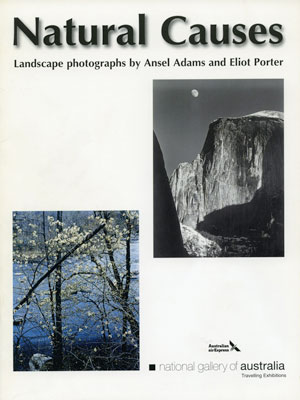 |
CHECKLIST
Dimensions are given in centimetres for the image area, height before width.
ANSEL ADAMS
United States 1902-1984
Meadow near Bishop Pass 1930, photogravure, 15.0x20.0 cm, 1987.1477
All the following works by Adams are gelatin silver photographs.
Lone Pine Peak, the Sierra Nevada, California 1960 from Ansel Adams Portfolio V, New York: Parasol Press Ltd., 1970
39.4 x 49.4 cm
1977.809.2
Petroglyphs, Monument Valley, Utah 1958 from Ansel Adams Portfolio V,New York: Parasol Press Ltd., 1970
38.9 x 49.8 cm 1977.809.5
Pinnacles, Alabama Hills, Owen Valley, California 1945 from Ansel Adams Portfolio V, New York: Parasol Press Ltd., 1970
39.5 x 48.2 cm
1977.809.8
Maroon Bells, near Aspen, Colorado 1951 from Ansel Adams Portfolio VI, New York: Parasol Press Ltd., 1974
38.8 x 49.0 cm 1977.810.3
Half Dome, blowing snow, Yosemite National Park, California 1955 from Ansel Adams Portfolio VII, New York: Parasol Press Ltd., 1976 39.2 x 49.4 cm 1977.811.9
El Capitan, sunrise, winter, Yosemite National Park, California 1968 from Ansel Adams Portfolio VII, New York: Parasol Press Ltd., 1976 48.8 x 39.2 cm 1977.811.10
The following works are from Ansel Adams Museum Set I, California: Ansel Adams Publishing Rights Trust, 1981.
Lodgepole Pines, Lyell Fork of the Merced River, Yosemite National Park, California 1921 32.6 x 25.6 cm 1981.3064.1
Monolith, the face of Half Dome, Yosemite National Park, California 1927 49.0 x 36.8 cm 1981.3064.2
Frozen lake and cliffs, the Sierra Nevada, Sequoia National Park, California 1930 36.6 x 47.2 cm 1981.3064.7
Rock and grass, Moraine Lake, Sequoia National Park, California 1932 36.4 x 45.4 cm 1981.3064.10
Grass and pool, the Sierra Nevada, California 1935 26.0 x 34.4 cm 1981.3064.12
El Capitan Fall, Yosemite National Park, California 1940 27.0 x 34.8 cm 1981.3064.30
Moonrise, Hernandez, New Mexico 1941 38.6 x 49.0 cm 1981.3064.31
The Tetons and the Snake River, Grand Teton National Park, Wyoming 1942 39.2 x 48.0 cm 1981.3064.32
White House ruin, Canyon de Chelly National Monument, Arizona 1942 39.4 x 49.2 cm 1981.3064.33
Leaves, Mount Rainier National Park, Washington 1942 47.4 x 37.0 cm 1981.3064.38
Winter Sunrise, the Sierra Nevada, from Lone Pine, California 1944 38.0 x 49.4 cm 1981.3064.40
Clearing winter storm, Yosemite National Park, California 1935 39.6 x 48.8 cm 1981.3064.41
Mount Williamson, the Sierra Nevada, from Manzanar, California 1944 39.0 x 46.2 cm 1981.3064.42
White House Ruin, Canyon de Chelly National Monument, Arizona 1947 49.5 x 37.0 cm
1981.3064.48
Dawn, Autumn, Great Smoky Mountains National Park, Tennessee 1948 49.6 x 57.2 cm
1981.3064.52
Oak tree, snowstorm, Yosemite National Park, California 1948 49.8 x 39.2 cm 1981.3064.53
Sand dunes, sunrise, Death Valley, California 1948 45.6 x 35.8 cm 1981.3064.54
Tenaya Creek, Dogwood, Rain, Yosemite National Park, California 1948 49.4 x 38.2 cm 1981.3064.55
Tenaya Creek, Dogwood, Rain, Yosemite National Park, California 1948 38.6 x 49.4 cm 1981.3064.56
Sequoia Gigantea Roots, Yosemite National Park, California c.1950 49.2 x 38.6 cm 1981.3064.57
Monument Valley, Arizona 1958 39.4 x 49.6 cm 1981.3064.64
Aspens, northern New Mexico 1958 48.4 x 37.9 cm1981.3064.65
Siesta Lake, Yosemite National Park, California 1958 39.6 x 49.2 cm 1981.3064.67
Moon and Half Dome, Yosemite National Park, California 1960 49.4 x 36.2 cm 1981.3064.69
Redwoods, Bull Creek Flat, northern California 1960 38.8 x 48.8 cm 1981.3064.71
Evening clouds and pool, east side of the Sierra Nevada, from the Owens Valley, California 1962 38.4 x 49.4 cm 1981.3064.72
JUDY DATER
born United States 1941
Ansel Adams 1977 gelatin silver photograph 45.1 x 35.7 cm 1980.3242
ELIOT PORTER
United States 1901-1990
All works by Porter are dye-transfer colour photographs.
Music Temple Glen Canyon, National Recreation Area, Utah 1962 33.8 x 26.0 cm 1978.924
Music Temple Glen Canyon, National Recreation Area, Utah 1962 33.6 x 25.9 cm
1978.925
Escalante River, Utah 1962 33.8 x 25.8 cm
1978.926
Chapel Pond. Adirondacks, New York 1965 25.9 X20.1 cm
1978.927
Beech leaves and tree tunks in snow Adirondacks, New York 1965 20.3 x 25.8 cm 1978.928
Sculptured rock. House Rock Canyon, Marble Canyon, Arizona. June 13, 1967 26.7 x 20.3 cm
1978.930
Shad tree. Great Smokey Mountains, Tennessee 1967 26.5 x 20.6 cm
1978.931
Iceland 1972 26.8 x 20.7 cm
1978.933
Ice cave. Scott Base, Ross Island, Antarctica. December 7, 1975 (Hut Point Peninsula, Site of Scott camp on first visit to Antarctica) 26.6 x 20.7 cm
1978.935
Argentine Islands. Antarctic Peninsula1975 22.1 x 32.7 cm 1978.936
The following works are from the portfolio Intimate landscapes New York: Daniel Wolf Press Inc., 1979. Edition no. 83/250.
Stones and cracked mud. Black Place, New Mexico. June 9, 1977 34.5 x 27.2 cm
1981.2540.1
Rock eroded stream bed.Coyote Gulch, Utah. August 14, 1971 34.4 x 27.2 cm
1981.2540.2
River edge at sunset. Below Piute Rapids, San Juan River, Colorado. May 24, 1962 34.6 x 27.3 cm
1981.2540.3
Frostbitten apples. Tesuque, New Mexico. November 21, 1966 34.3 x 27.2 cm 1981.2540.4
Trunks of maple and birch with oak leaves. Passaconaway Road, New Hampshire. October 7, 1956 33.9 x 26.9 cm 1981.2540.5
Columbine leaves. Great Spruce Head Island Maine. July 27, 1974 33.7 x 27.3 cm
1981.2540.6
Shadbush. Near Hillsborough, New Hampshire. April 28, 1957 34.5 x 27.2 cm
1981.2540.7
Foxtail grass. Lake City, Colorado. August 1957 33.8 x 27.3 cm
1981.2540.8
Colorful trees. Newfound Gap Road, Great Smokey Mountains National Park, Tennessee. October 1967 33.8 x 27.1 cm 1981.2540.9
Redbud trees in Bottomland. Near Red River Gorge, Kentucky. April 17, 1968 33.3 x 27.2 cm 1981.2540.10
Pool in a brook. Pond Brook, near Whiteface, New Hampshire. October 1953 large edition print 92.6 x 72.4 cm 1999.182
Ansel Adams' photographs were reproduced courtesy of the Ansel Adams Publishing Rights Trust, California, 1999, a body established to ensure the continued publication of Adams' work with the integrity and quality achieved by the artist in his lifetime.
Eliot Porter's photographs were reproduced courtesy of the Amon Carter Museum, Fort Worth, Texas, bequest of Eliot Porter.
more of Gael Newton's Essays and Articles
|